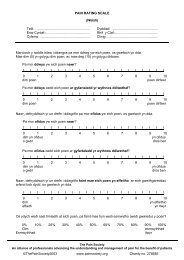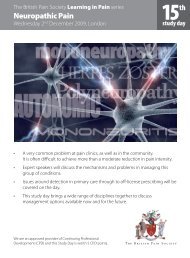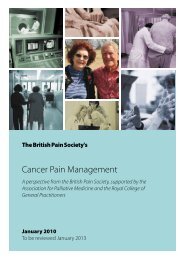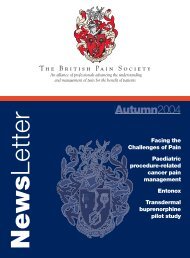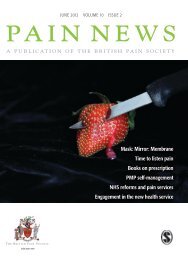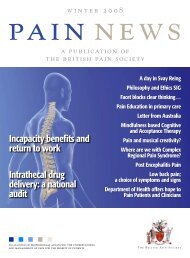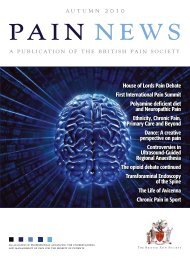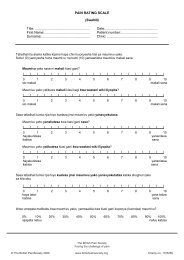Summer 2010 - The British Pain Society
Summer 2010 - The British Pain Society
Summer 2010 - The British Pain Society
You also want an ePaper? Increase the reach of your titles
YUMPU automatically turns print PDFs into web optimized ePapers that Google loves.
Papers appraised by Dr Aileen Clyde <strong>Pain</strong> Fellow Glasgow<br />
PAIN SHORTCUTS<br />
Incidence and Root Cause<br />
Analysis of Wrong-site <strong>Pain</strong><br />
Management Procedures<br />
Anesthesiology <strong>2010</strong>;112:711-8<br />
<strong>The</strong> objectives of this study were<br />
to estimate the incidence of wrong<br />
site pain management procedures,<br />
to perform an analysis to identify<br />
the cause of these mistakes and to<br />
publicise the issue of wrong site<br />
surgery and its causes to prevent<br />
further occurrences.<br />
Quality improvement records<br />
were reviewed from pain clinics<br />
at 10 institutions in the USA (<br />
4 academic teaching hospitals,<br />
2 military teaching hospitals, 1<br />
non-academic treatment facility<br />
and 3 private practices) during<br />
a 2 year period from 2007-2009<br />
to identify wrong site procedure<br />
events. All physicians involved in<br />
pain management at each facility<br />
were questioned to identify wrong<br />
site procedures that may not have<br />
been reported. Billing records from<br />
the non-military institutions were<br />
examined and procedure codes<br />
and scheduling records from the<br />
military institutions examine to<br />
identify the total number of pain<br />
procedures carried out in this 2<br />
year period. When multiple distinct<br />
procedures were performed<br />
during a single visit, these were<br />
counted separately. For related<br />
or multilevel procedures that did<br />
not constitute an additional risk of<br />
wrong site surgery, then only the<br />
primary procedure was tabulated.<br />
Individual procedure reports<br />
were examined during a 6 month<br />
period to determine the number<br />
of unilateral procedures or spinal<br />
procedures in which correctly<br />
identifying the pathological level<br />
was deemed to be critically<br />
important. <strong>The</strong>se procedures<br />
were called ‘at risk’ procedures.<br />
Causation was determined by<br />
referring to quality improvement<br />
records and by ‘debriefings’ with<br />
personnel involved in the event.<br />
<strong>The</strong> review found that 48,941<br />
unrelated procedures were<br />
completed at the 10 institutions<br />
during the 2 year time frame. <strong>The</strong><br />
review of 500 billing records along<br />
with daily schedules and electronic<br />
record review indicated 6 duplicate<br />
procedures or procedures that<br />
were not reflected in the billing<br />
records. This gives an estimated<br />
error rate of 1.2%.<br />
13 wrong site procedures were<br />
identified (0.027%; CI 0.01-<br />
0.05%). 12 were from quality<br />
improvement records and 1 from<br />
staff questioning.<br />
<strong>The</strong> proportion of ‘at risk’<br />
procedures from each institution<br />
ranged from 39-65%, the<br />
weighted average was 52.4%.<br />
<strong>The</strong>refore, the incidence of<br />
wrong site procedures was<br />
estimated to be 2.7 per 10,000<br />
pain management procedures<br />
and 5.1 per 10,000 high risk pain<br />
management procedures.<br />
Of the 13 wrong site procedures,<br />
5 were wrong side transforaminal<br />
epidural steroid injections.<br />
<strong>The</strong>re was 1 wrong side facet<br />
radiofrequency denervation, 1<br />
wrong side intercostal nerve radio<br />
frequency ablation, 1 wrong side<br />
intercostal nerve block, 2 wrong<br />
level spinal procedures, 1 wrong<br />
side lumbar sympathectomy, 1<br />
wrong side suprascapular nerve<br />
block and 1 wrong side lumbar<br />
facet injection.<br />
In 5 cases either the side or level<br />
was not noted on the consent<br />
form. In four of the 8 cases where<br />
the consent form was correct, it<br />
was signed by a different person<br />
to that carrying out the procedure.<br />
In one patient the consent form<br />
was not sent with the patient to<br />
the procedure area. A ‘time out’<br />
was performed in only 6 of the 13<br />
cases and the side was marked in<br />
only 2 cases.<br />
<strong>The</strong> authors identified some<br />
causative factors which appear<br />
to increase the chances of wrong<br />
site surgery. <strong>The</strong>re appeared to<br />
be an increased risk of wrong site<br />
procedures when the responsibility<br />
for safe performance is shifted<br />
between providers, steps in the<br />
‘universal protocol’ are missed,<br />
the site is not marked, bilateral<br />
pathology is present or if a<br />
different practitioner from the<br />
one carrying out the procedure<br />
is involved in obtaining consent.<br />
Strangely in 8 of the 13 cases the<br />
patients knew that the wrong side<br />
Anesthesiology 111(2), August 2009<br />
pp416-431<br />
Intravenous analgesic infusion tests<br />
have been used for some time to<br />
facilitate the management of patients<br />
with chronic pain. <strong>The</strong> rational<br />
behind their use is that they can<br />
quickly predict who will respond<br />
to a subsequent course of oral<br />
medication, eliminating the time and<br />
expense of an oral medication trial<br />
and reducing the risks of adverse<br />
effects associated with ineffective<br />
drug treatment.<br />
This is the first attempt to review<br />
systematically the literature on<br />
intravenous analgesic infusion tests.<br />
<strong>The</strong> aim of the systematic review<br />
was to discern the value of these<br />
analgesic drug infusions tests as<br />
prognostic tools in guiding future<br />
drug therapy.<br />
was being targeted. 6 of the 13<br />
patients received sedation for the<br />
procedure.<br />
No legal, professional or<br />
procedural consequence resulted<br />
from the errors although 2<br />
practices determined that the<br />
mistake might lead to future litigation.<br />
No studies like this have been<br />
conducted to determine the<br />
incidence of wrong site pain<br />
procedures in the UK. <strong>The</strong> WHO<br />
surgical safety checklist, which has<br />
recently been implemented in many<br />
UK hospitals may help to reduce the<br />
problem of wrong site procedures.<br />
It is interesting to note that in many<br />
of the wrong site pain procedures<br />
mentioned in this study, there was<br />
a breach of universal protocol (U.S.<br />
version of surgical safety checklist)<br />
PAIN SHORTCUTS<br />
Intravenous Infusions for<br />
Chronic <strong>Pain</strong>- a systematic<br />
review<br />
<strong>The</strong> authors performed a MEDLINE,<br />
EMBASE and OVID search using<br />
appropriate key words. <strong>The</strong> search<br />
identified 111 published articles on<br />
the subject. Of these 22 articles were<br />
suitable for analysis.<br />
10 studies looked at the predictive<br />
value of lignocaine infusion tests for<br />
treatment with oral sodium channel<br />
blocker mexiletine. Although these<br />
studies are small the data suggests<br />
that a brief lignocaine infusion test is<br />
predictive of subsequent response<br />
to oral mexiletine for patients with<br />
neuropathic pain. <strong>The</strong>re is only<br />
weak evidence that the response to<br />
intravenous lignocaine can predict<br />
response to mexiletine in nociceptive<br />
pain. <strong>The</strong> authors point out that the<br />
long term effectiveness of mexiletine<br />
therapy remains in question as a<br />
result of its significant side effect<br />
profile, mainly nausea and sedation.<br />
6 0<br />
PAI N N E W S S U M M E R <strong>2010</strong>




